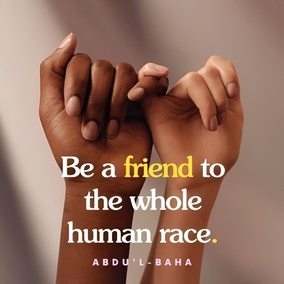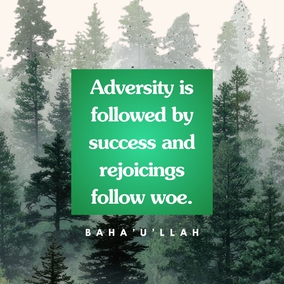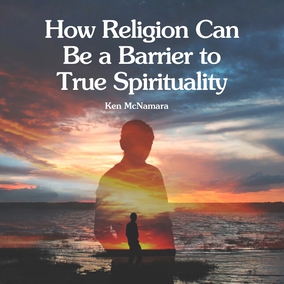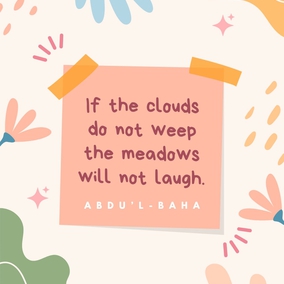The views expressed in our content reflect individual perspectives and do not represent the authoritative views of the Baha'i Faith.
O My eminent friend! Those who progress in mystic wayfaring are of four kinds. I shall describe them in brief, that the grades and qualities of each kind may become plain to thee. – Baha’u’llah, The Four Valleys, p. 49.
Baha’u’llah ends the introduction to his short book on spiritual search and maturation, The Four Valleys, by saying “those who progress in mystic wayfaring are of four kinds.”
In this four-step model of spiritual search, growth and maturation, Baha’u’llah reveals an ancient and yet completely new way of seeing our human progression and growth as a journey of the soul. He presents that journey as a path through four separate “valleys.” A valley, according to Cirlot’s Dictionary of Symbols, stands for:
…a neutral zone apt for the development of all creation and for all material progress in the world of manifestation. Its characteristic fertility stands in contrast to the nature of the desert (symbolically a place of purification), of the ocean (which represents the Origin of life but which, in relation to man’s existence, is sterile), and of the mountains (the region characterized by snows and the ascetic, contemplative life, or by intellectual illumination). In short, the valley is symbolic of life itself and is the mystic abode of shepherd and priest. – p. 339.
This perennial four-stage philosophy of spiritual growth, which echoes throughout all the major religious traditions, represents the evolving maturity of our being or consciousness as a hierarchy of four steps, stages, dimensions or levels. We move along that maturing path, as the philosopher Ken Wilber says, “from the lowest, densest and most fragmentary realms to the highest, subtlest and most unitary ones.”
The ancient wisdom of the four-step or four-fold path has existed throughout religious history, charting our spiritual growth as a maturational quest on the path from self to selflessness.
 We see those four stages represented scientifically by the earthly classifications of mineral, plant, animal and human, or by the four seasons of the year. They’re often represented symbolically by the four elements: earth, water, fire and air. We see them represented metaphorically as the movement from infant to child to youth to adult. We see them in the traditional four ways of attaining knowledge: the senses, reason, tradition and inspiration. We see them analogically as a gradual progression from inner-directed to other-directed. These four-step cosmologies closely correspond with many of the level-specific psychological and moral growth models like Kohlberg’s and Maslow’s.
We see those four stages represented scientifically by the earthly classifications of mineral, plant, animal and human, or by the four seasons of the year. They’re often represented symbolically by the four elements: earth, water, fire and air. We see them represented metaphorically as the movement from infant to child to youth to adult. We see them in the traditional four ways of attaining knowledge: the senses, reason, tradition and inspiration. We see them analogically as a gradual progression from inner-directed to other-directed. These four-step cosmologies closely correspond with many of the level-specific psychological and moral growth models like Kohlberg’s and Maslow’s.
One of the many ways to look at Baha’u’llah’s The Four Valleys revolves around its suggestion of a four-level hierarchy of personal and spiritual growth, with each level taking its name from the first line in each “valley:” self; reason; love; and finally, the apex of consciousness.
The first valley, centered around Baha’u’llah’s emphasis on self-discovery, could be called the valley of self. In the first valley Baha’u’llah says “this station appertaineth to the self…” “On this plane,” he continues, “the self is not rejected but beloved; it is well-pleasing and not to be shunned.” This first valley, which corresponds nicely with the initial one of Baha’u’llah’s Seven Valleys–and the first stage of all the perennial philosophy models–focuses on the discovery of self as the starting place for all spiritual attainment. Here, Baha’u’llah encourages the seeker to study the map of his own soul, and to look within for the deep understanding which guides all search. This valley also represents the central Baha’i principle that asks each person to conduct their own independent investigation of truth.
In the second valley, Baha’u’llah writes “this is the station of primal reason….” – p. 52. In other places, notably The Seven Valleys, Baha’u’llah uses the word reason almost interchangeably with the word knowledge. All of the four-level cosmologies use some variant of this concept of knowledge or the discovery of logic and reason to describe the opening of the higher mind, the human intellect, to spiritual search and the promptings of the soul. Accordingly, we could call this stage the valley of reason or the valley of knowledge. Here, in the second valley, the newly-discovered self transcends its self-awareness, supplanting it with a broader consciousness which allows it to see beyond the boundaries of the first valley, and into the mysterious heart of symbols and signs.
In the third valley, Baha’u’llah wrote that:
…no soul may dwell on this Kingly Throne save the beauty of love… On this plane, neither the reign of reason is sufficient nor the authority of self. – pp. 54-55.
Here he emphasized the attainment of love and pure affection for the Eternal, after the stages of search for self and growing self-knowledge have been surpassed. This stage focuses on the great yearning of the human heart and soul for beauty, transcendence and connection with the Creator. Baha’u’llah clearly says that “This realm is not to be pictured in words,” and spends most of the short duration of his description of the third valley quoting from the Qur’an and Rumi’s Mathnavi: “The lover’s teacher is the Loved One’s beauty.” We could call this stage of human development the valley of the beauty of love.
Baha’u’llah calls the fourth valley “the apex of consciousness and the secret of divine guidance,” and “the realm of full awareness, of utter self-effacement.” He says that “Astonishment here is highly prized, and utter poverty essential.” The idea of a highly-developed consciousness striving for selflessness and self-effacement resonates with the Buddhist concept of nirvana, which literally means “non-drawing”, as a fire ceases to draw; with the Hindu idea of nirguna, which means “without qualities”; or the mystical Jewish theory of ’en-sof, the “not-finite.” This final stage of human development, then, we could refer to as the valley of the apex of consciousness.
















Comments
Sign in or create an account
Continue with Googleor